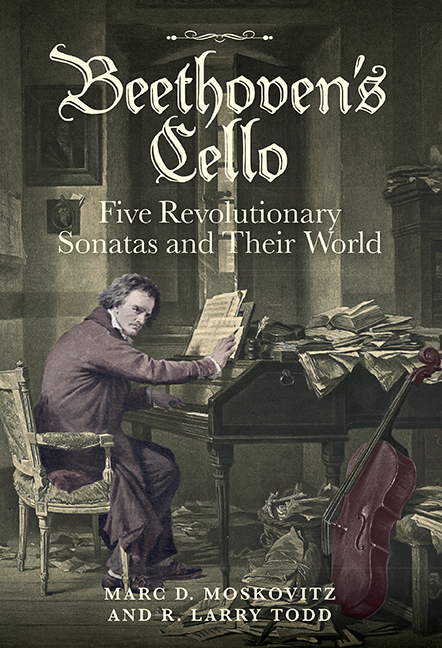Book contents
- Frontmatter
- Dedication
- Epigraph
- Contents
- Illustrations
- Foreword by Steven Isserlis
- Preface
- Personalia
- 1 From Bonn to Berlin
- 2 Music Fit for a King: The Sonata in F major Op. 5 No. 1 (1796)
- Interlude: Beethoven's Cellos
- 3 Tragic/Comic Masks: The Sonata in G minor Op. 5 No. 2 (1796)
- Interlude: Beethoven's Pianos
- 4 Themes and Variations
- Interlude: The Triple Concerto as Outlier
- 5 Friendship, War, Tears, and Grief: The Sonata in A major Op. 69 (1808)
- 6 Freedom and Control: The Sonata in C major Op. 102 No. 1 (1815)
- 7 ‘Most Remarkable and Strange’: The Sonata in D major Op. 102 No. 2 (1815)
- Interlude: Arranged Sonatas
- 8 Opus Posthumum
- Appendix 1 Primary Sources of Beethoven's Music for Cello and Piano
- Appendix 2 Reviews of Beethoven's Cello Music by His Contemporaries
- Notes
- Bibliography
- Index of Works by Beethoven
- General Index
2 - Music Fit for a King: The Sonata in F major Op. 5 No. 1 (1796)
Published online by Cambridge University Press: 18 April 2018
- Frontmatter
- Dedication
- Epigraph
- Contents
- Illustrations
- Foreword by Steven Isserlis
- Preface
- Personalia
- 1 From Bonn to Berlin
- 2 Music Fit for a King: The Sonata in F major Op. 5 No. 1 (1796)
- Interlude: Beethoven's Cellos
- 3 Tragic/Comic Masks: The Sonata in G minor Op. 5 No. 2 (1796)
- Interlude: Beethoven's Pianos
- 4 Themes and Variations
- Interlude: The Triple Concerto as Outlier
- 5 Friendship, War, Tears, and Grief: The Sonata in A major Op. 69 (1808)
- 6 Freedom and Control: The Sonata in C major Op. 102 No. 1 (1815)
- 7 ‘Most Remarkable and Strange’: The Sonata in D major Op. 102 No. 2 (1815)
- Interlude: Arranged Sonatas
- 8 Opus Posthumum
- Appendix 1 Primary Sources of Beethoven's Music for Cello and Piano
- Appendix 2 Reviews of Beethoven's Cello Music by His Contemporaries
- Notes
- Bibliography
- Index of Works by Beethoven
- General Index
Summary
ALTHOUGH NO EYEWITNESS ACCOUNT survives of Beethoven's premiere of his first cello sonatas before the Prussian monarch, we can attempt to conjure up the scene. Granted a highly coveted audience, and dressed in formal attire - perhaps finery purchased for the occasion - Beethoven placed himself at one of the king's ornate, handsomely appointed instruments, likely a Silbermann fortepiano. Reading from his now lost manuscript, and in the company of the king's cellist, Jean-Louis Duport, Beethoven set his fingers on the keys - either two, for the F major, or seven, for the G minor sonata - and delivered the inaugural notes of his first venture into the intimate world of the piano and cello ensemble …
Admittedly fiction, this scene may not stray far from the truth. But what is certain is that Beethoven offered up sonatas radically unlike any written for the king or experienced before, in Berlin or elsewhere. Their effect at court must have been breathtaking. Until the spring of 1796, sonatas involving the cello had either foregrounded the instrument as the soloist (the continuo sonata) or harnessed it to the bass line of a keyboard sonata (as in the accompanied piano sonata). But when Beethoven's Op. 5 appeared in print in 1797, the cover proclaimed the work's novel intent: Deux grandes Sonates pour Le Clavecin ou Piano=Forte avec un Violoncelle obligé (‘Two Grand Sonatas for the Harpsichord or Pianoforte with Obbligato Cello’; see Illustration 7). There is admittedly a fair amount to parse here, including the appearance of the clavecin (harpsichord), listed before the piano - surely the publisher's convention, not a preference of the composer - and the curiosity that Artaria, Beethoven's Viennese publisher, released the sonatas with a French title (to be revisited in Chapter 3). But the prominence Beethoven accorded the keyboard, even if now challenged by an ‘obligatory’ cello part, clearly suggests that for him Op. 5 sprang from the traditional accompanied piano sonata that had culminated in Mozart's violin sonatas of the later 1770s and 1780s. And so at age twenty-six Beethoven effectively announced a new, durable genre of the duo sonata in which the cellist assumed a heightened role nearly on a par with the keyboard.
- Type
- Chapter
- Information
- Publisher: Boydell & BrewerPrint publication year: 2017

